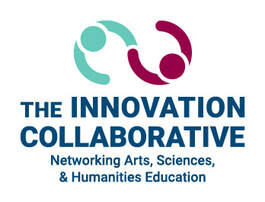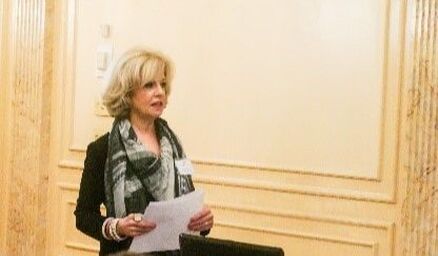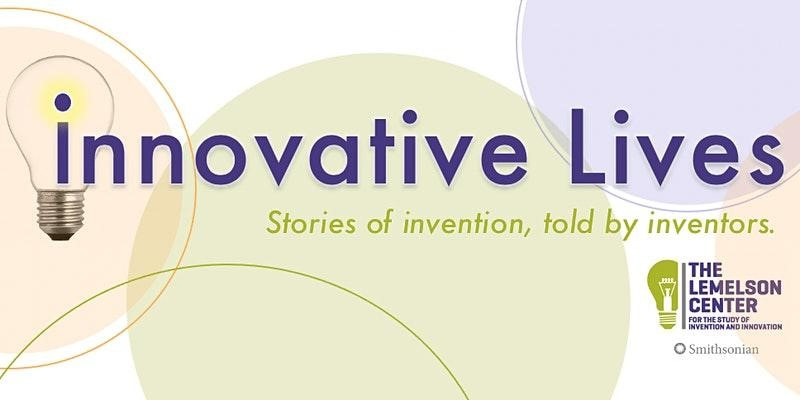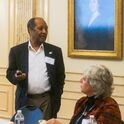 The Collaborative’s Research Thought Leaders help provide the strong research foundation upon which the Collaborative’s work rests. Each Thought Leader is nationally and internationally recognized in their own field and brings an extensive depth of experience and expertise. They also are adept at working across disciplines. In our previous newsletters, we brought you interviews with each of our Thought Leaders. This new series will consider how you might apply some of their most important ideas in your STEAM work. To do so, we’ll use examples of the Collaborative’s successful application of these ideas in K-12 classroom implementation and teacher professional development. This first in a series of articles looks at STEAM’s relation to creativity and innovation. Future series articles will look at such topics as equity; interdisciplinarity; applications of these concepts to learning settings; STEAM educator training; and creating effective STEAM models. The easily readable information below is built upon the Thought Leaders’ newsletter interviews, on conversations with them, and on an in-person convening in Washington, DC, that was supported in part by the National Endowment for the Arts. Creativity and Innovation For the Collaborative, the definition of creativity relates to novel ideas, while innovation refers to the application of those novel ideas to appropriate uses. THOUGHT LEADER INPUT
APPLICATION
0 Comments
 In its position as a national STEAM education trailblazer, the Innovation Collaborative has adopted its position on STEAM education. This position was thoughtfully developed by a team of Collaborative leaders representing arts, science, and humanities institutions, with continuous input by all Collaborative members across disciplines and learning settings. In this position statement, the Collaborative emphasizes the importance of equity, curiosity, and the application of competencies and practices across disciplines. These competencies and practices include, but are not limited to, fluency, originality, imagination, collaboration, problem-solving, risk-taking, and persistence. See Applying Research Thought Leader Wisdom article in this newsletter for more on applying creativity and innovation. The Collaborative’s STEAM position also emphasizes the importance of transdisciplinary learning. In this approach, boundaries are erased among disciplines, increasing learning in addition to cognitive and affective growth. 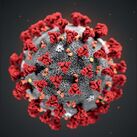 In the last newsletter we summarized just a few of the ways in which educators and guides have innovated to provide effective COVID learning environments when traditional methods were not possible. Over the past year, this process has progressed with additional thoughtful approaches and also research-based analyses of where we are and how we might move forward. Coping through Literature and the Arts More and more, thought leaders are looking beyond the current health crisis to plan for recovery. This includes not only economic and structural measures but also intense attention to psychological and emotional crises that the pandemic has caused. Increasingly, writers are recognizing the important role that literature and the arts have and must continue to play in this process. Here are just a few of the resources and articles that have appeared in the past few months: Trade Literature to Help Students Understand (Recommended by Angela Ding at Worlddreader.Org) The Unwelcome Stranger, by Drew Edwards & Diana Nawatene A grandfather advises children how to cope and be kind. I Love You, by Michael Ross Kwizera does not understand why she cannot be physically with her grandparents. Coronavirus: A Book for Children, by Elizabeth Jenner, Kate Wilson, Nia Roberts, & Axel Scheffler This non-fiction book answers questions children might have about the coronavirus. Hello, My Name is Coronavirus, by Manuela Molina Cruz An informative book narrated by the virus, itself. My Hero Is You, by Helen Patuck Sarah is upset because she cannot go to school. She feels unsafe. An imaginary dragon gives her comfort. The Virus-Stopping Champion by, Hilary Rogers A short story convinces children that they, too, can be champions. Read more at https://www.worldreader.org/now/6-books-to-help-your-children-understand-the-coronavirus/ Poetry for the Pandemic And the People Stayed Home (Family Book, Coronavirus Kids Book, Nature Book), by Kitty O'Meara A beautifully-illustrated poem that reflects the angst of in today’s world. Arts for an Anxious World - and More
How Art Helps Us Make Sense of COVID 19’s Incredible Toll. (from National Geographic) Contributed by Collaborative Innovation Fellow Julie Olson In a field outside of JFK Memorial Stadium in Washington, DC, artist Susan Brennan Firstenberg’s art helps Americans visualize our shared grief—a flag for every one of our COVID deaths. People come and help, praying and giving physical manifestation to what we are all experiencing. That is one of many memorials that have bloomed across the country. Another is by a thirteen-year old student in Sherman Oaks, California, who is spearheading the creation of a quilt. Eventually, all panels of this quilt will be assembled. Like these exhibits, other art installations throughout the country are addressing the country’s shared COVID experiences. https://www.nationalgeographic.com/history/2020/11/how-art-helps-make-sense-covid-19-incomprehensible-toll/ Our Kids Need Arts Education More than Ever: Here’s What’s Lost Without It (from Time) Frank Gehry calls on President Biden to empower school-age children to help heal themselves by restoring arts education because the arts…(help them) express and channel their emotions…and find their spirit’s song. He urges this emphasis on the arts so that children have the creative powers necessary to solve the problems we are leaving behind. https://www.msn.com/en-us/news/us/our-kids-need-arts-education-now-more-than-ever-heres-what-is-lost-without-it/ar-BB1c6Q9j?ocid=msedgdhp/ From the National Academies of Sciences, Engineering, and Medicine Teaching K-12 Science and Engineering During a Crisis The COVID-19 pandemic is resulting in widespread and ongoing changes to how the K–12 education system functions, including disruptions to science teaching and learning environments. This report describes high-quality instruction today, with tips for administrators, teachers and others. It emphasizes quality and equity, giving advice for managing and monitoring instruction. The free publication is available for download from the National Academies. https://www.nap.edu/resource/25909/interactive/?fbclid=IwAR0cufKezzb_-cCrlbi4skWinZk5SXkD2VQRlFV2zWdxZ86y-6qw8sy-xTw#.X3ZJmWof3RA.facebook And for lightness and pure joy… Pre-K Teacher Goes Viral After Sharing Virtual Classroom Dance Parties: “It’s About Bringing That Joy Factor” Azel Prather, Jr., went viral when he shared his virtual pre-school dance party on YouTube. Pre-pandemic, Prather taught preschool at Kipp DC Arts and Technology Academy in Washington, DC. He has long recognized those children who were “dancing in their seats” when they were supposed to be learning sight words. Dance was part of the program then and it is now, through Instagram and other social media tools. https://www.yahoo.com/lifestyle/pre-k-teacher-goes-viral-after-sharing-virtualclassroom-dance-parties-its-about-bringing-that-joy-factor-165553012.html The approaches above are different, but the message is clear. Moving forward, education will never be the same.  The Educational Theatre Association’s (EdTA) August survey, “The Impact of COVID-19 on Theatre Education,” has confirmed the profound effect of the pandemic on school theatre throughout the United States, leaving many programs at significant risk in the coming years. The survey queried more than 11,000 middle and high school theatre educators about the status of their programs in the pandemic environment. Nearly 2,400 teachers responded, offering a snapshot of how COVID-19 has reshaped both their teaching methods and student learning opportunities. Analysis shows programs have suffered substantial revenue losses, with 91% of schools forced to cancel performances in spring 2020. For many programs, ticket revenue provides the main source of funding, as 44% receive no financial support from their districts. Money lost to investments in canceled productions coupled with lack of spring ticket sales created a ripple effect on current season budgets. In fact, 22% of programs faced cuts for the 2020-21 academic year. Many survey respondents reported 2019-20 revenue losses that were substantially more than they earned, and it is likely the economic downturn will limit other funding support this school year and beyond. For teachers, the impact raises short-term concerns about student recruitment, morale, and motivation as well as longer-term uncertainty about reductions in program capacity, external funding, and student opportunities. According to James Palmarini, Collaborative Advisory Council member and EdTA policy and advocacy advisor, the cancellations and lost revenue numbers were not unexpected, but still troubling. “We knew many theatre programs had to cancel their shows in the spring, but the numbers regarding those lost productions and revenue are still very sobering,” he said. Palmarini added there was hope from respondents for the current school year, with 59% answering “maybe” and 19% “yes” to a question regarding whether they thought they would produce a live show in 2020 or 2021, and 97% indicating they were returning to their positions in fall 2020. Seventy-five percent of educators stated they were starting the school year entirely virtually or in a hybrid model. The data on how they are adapting to the virtual environment suggests a broad range of strategies, with no predominant mode for reaching students. In the spring of 2020, the most frequently realized instructional strategies were virtual lessons taught asynchronously and available on-demand; project-based lessons spanning multiple class periods; instructional videos or digital games; and digital versions of lesson packets with worksheets. EdTA will conduct a follow up survey in the Summer of 2021. For a comprehensive summary of the survey results visit the EdTA Rapid Response Advocacy Center. 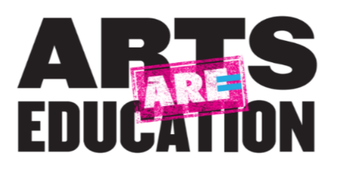 The National Coalition for Core Arts Standards (NCCAS) has launched Arts ARE Education, a national campaign encouraging school districts to continue to fund and support K-12 arts education programs in the 2021-22 school year. Given expected state and district budget cuts, calls for remedial education in tested subject areas, and the continued need for PPE equipment, NCCAS expects that arts programs across all disciplines will be at risk. The campaign asks advocates of all ages to take these action steps through its website:
He added that the campaign is also mindful that students of color in high poverty districts are most likely to lose arts education access, given the limited resources the districts will have to continue with arts programs. “I think the Arts ARE Education campaign offers theatre education (and all arts education) advocates a great opportunity to raise their voices in a very grassroots way that can make a real difference for our students and the fields of theatre and all arts education.” The Smithsonian has announced the 2021 Innovative Lives series. Over the past 25 years, the Institution’s Lemelson Center has hosted the Innovative Lives program series featuring more than 85 inventors, innovators, and entrepreneurs. Attendees can participate in informal chats. This year, Lemelson programs focus on diversity and inclusion in the invention ecosystem. The webinars in the series are open for free registration. Below are upcoming events. March 10: Growing Up with an Inventor and Sharing their Story through Film will feature documentary filmmakers Rob Lemelson and Cindy Yoon sharing stories and film clips from documentaries about their famous inventor-fathers.
April 14: Marilyn Hamilton, co-inventor of the Quickie Wheelchair, will speak with NMAH (National Museum of American History) curator Katherine Ott about her life as an athlete and inventor. May 12: Sarah Will, Paralympic skier and accessibility advocate, and Mike Schultz, inventor of the Moto Knee and Versa Foot, will come together to talk with NMAH sports curator Jane Rogers about their respective careers. Register for Growing Up with an Inventor |
